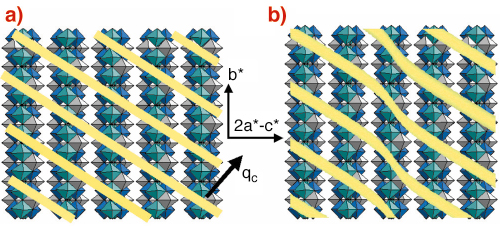- Home
- Users & Science
- Scientific Documentation
- ESRF Highlights
- ESRF Highlights 2005
- X-ray Absorption and Magnetic Scattering
- Evidence of Topological Defects in an Electronic Crystal
Evidence of Topological Defects in an Electronic Crystal
Electron confinement, for example along chains of atoms, give rise to original phenomena. These effects are observed in charge-density wave (CDW) materials. Upon cooling, these materials exhibit a modulation of the electron density along the chains and become insulating. Moreover, under a large enough electric field, a strong decrease of the resistivity is observed. This phenomena, still under debate, is generally interpreted as being caused by a collective “sliding” of the CDW as a whole [1].
This CDW can be considered as an electronic crystal, ordered in the three directions of space. In particular, its wave number along the chain is equal to twice the momentum of the fastest electrons of the system: 2kF. Like a crystal, this electronic system is elastic and can exhibit dislocations. Predicted theoretically for 25 years [2], such topological defects are thought to play an essential role in the behaviour of the CDW under electric field. In a similar way dislocations in metals explain metal plasticity.
 |
|
Fig. 121: Schematic representation of the Blue bronze CDW in the ( 2a*-c* ; b* ) plane in a) a defect-free crystal and b) a crystal with a screw-like dislocation line running along b* in the middle of the figure. Only Mo octahedra are represented. Yellow lines represent the constant phase wave front of the CDW. Note that this dislocation does not introduce any dilatation or compression of the CDW along b*. |
The direct observation of CDW dislocations has never been achieved. Our recent experiment on the ID20 beamline has shown that coherent X-ray diffraction measurements are very sensitive to such topological defects. In the model system called “blue bronze” (a molybdenium oxide of formula K0,3MoO3), the structure of a CDW dislocation imbedded in the bulk has been studied. The interference fringes of the Figure 122b are interpreted as originating from the presence of a screw dislocation running along the chain axis. Since the one-dimensional CDW wave vector qc is not parallel to the chains axis, this topological defect corresponds to a mixed dislocation (between screw and edge), running along the chains direction (see in Figure 121b). Remarkably, this dislocation introduces no energy expensive compression or dilatation of the CDW along the chains, but involves only shears: due to the charged character of the CDW, this is expected to cost less energy than an edge dislocation.
 |
|
Fig. 122: 2D diffraction patterns of the Qs = (5,-1,-3)+qc satellite reflection corresponding to a) Figure 121a and b) Figure 121b, at T = 75 K. c) Fit of the t*-scan of b) using the Fourier transform of the screw like dislocation shown in Figure 121b. |
Beyond CDW systems, this study shows that coherent X-ray diffraction is well suited to probe any phase field deformation in the bulk, in nearly perfect lattices.
References
[1] H. Fröhlich, Proc. Roy. Soc. (London) A223, 296 (1954).
[2] P. A. Lee, T. M. Rice, Phys. Rev. B, 19, 3970 (1979).
Principal publication and Authors
D. Le Bolloc’h (a), S. Ravy (b), J. Dumas (c), J. Marcus (c), F. Livet (d), C. Detlefs (e), F. Yakhou (e), and L. Paolasini (e), Phys. Rev. Lett. 95, 116401 (2005).
(a) Laboratoire de Physique des Solides, Université Paris Sud, Orsay (France)
(b) Synchrotron SOLEIL, Gif-sur-Yvette (France)
(c) LEPE/S - CNRS/25, Grenoble (France)
(d) LTPCM, Saint Martin D’Hères (France)
(e) ESRF



